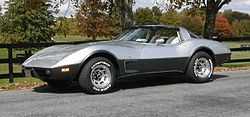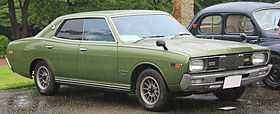Coke bottle styling




Coke bottle styling is any automotive body styling that bears an overall body shape resembling the classic glass Coca-Cola soft drink's contour bottle design when viewed in profile.[1] It is a style of automobile bodies with outward curving fenders with a narrow center.[2] In contrast to "straight-edge" designs, automobiles such as the sixth generation AMC Ambassador featured "swoopy lines ... in the 'Coke bottle' mode."[3]
The design was used in airplanes as a way of greatly reducing the sharp drag rise that occurs at transonic speeds; its utilization often results in a pinch-waisted fuselage shape that National Advisory Committee for Aeronautics (NACA) labeled the design principle 'area rule,' and variously identified as coke bottle, wasp waist, or Marilyn Monroe shape.[4]
Development
Studebaker introduced the Raymond Loewy-designed Avanti with pronounced Coke-bottle look in 1962.[5] The 1962 Pontiac full-size models also "had a subtle horizontal crease about half way down [the bodyside] and a slight wasp-waist constriction at the doors which swelled out again in the rear quarters"[6] One of the cleanest examples of the “Coke bottle” styling was the 1963 Buick Riviera.[7]
Automotive designers quickly succeeded to incorporate the "wasp waist" body shape among numerous passenger cars, as they found that the previous "ponton" appearance seemed dated. Chevrolet first tried the coke bottle look on Bill Mitchell's 1963 Corvette Sting Ray as a styling theme since the area rule does not apply at road speeds.[8] By 1966, the General Motors A-body sedans received a mid-riff pinch and "hop up" fenders. The 1968 Corvette looked even more like a bottle bulging at both ends and a narrow middle. Intermediates such as the Pontiac Tempest, Dodge Charger, and Ford Torino soon followed suit, as well as compacts such as the Ford Maverick and Plymouth Duster. General Motors also styled their "B" body full-size cars from 1965-68 with this style, which is most prominent on the "fastback" 2-door hardtop models. Chrysler's "interpretation of the Coke-bottle styling treatment to its struggling B-body cars ... [resulted in] ... smooth lines, subtly rounded curves, and near perfect proportions."[9] Design "themes" such the "hop up" fenders became so pervasive across the industry that American Motors' all-new 1967 Rebel was criticized because "viewed from any angle, anyone other than an out-and-out car buff would have trouble distinguishing the Rebel from its GM, Ford, and Chrysler Corp. competition."[10] Notable automobiles with this style include many of the muscle cars during this era, such as the Pontiac GTO, Chevrolet Camaro, and Dodge Charger.[1]
As tailfins were influenced by jet aircraft of the 1950s, stylists such as Ford stylist Bill Shenk (who designed the 1970 Ford Torino) were inspired by supersonic planes. Aircraft such as the F-102 were designed with narrow waists and bulging forward and rear fuselages to conform to the area rule to achieve supersonic speeds.[11] However, author Clinton Walker described the archetypal product of Australian suburbia - the muscle car - with its "Coke bottle hip bump but the bare midriff of a go-go dancer?"[12]
This styling "was to be seen right across the marketplace and, before long, around the world."[7] Japanese, European, and Australian automobiles also adopted this style during the 1970s. Japanese automaker Nissan offered this appearance on 1970s era Nissan Cedrics, Nissan Glorias, Nissan Laurels, Nissan Bluebirds, and Nissan Violets. Toyota also offered this appearance on the 1972-1976 Toyota Corona Mark II, and their limited production sportscar called the Toyota 2000GT. Mitsubishi also adopted this appearance on the 1973-1980 Galant, and the 1973-1979 Lancer. The smallest car with this style is usually considered to be the 1967 Suzuki Fronte 360, which was less than 3 metres (10 ft) long.,[13] while the Subaru 360 also used similar styling elements, notably the curvaceous "belt line". The appearance was even used in popular culture in the Japanese anime Speed Racer's Mach 5.
Not all cars displayed the full "plan-view" Coke bottle styling, with the waist narrowing. Some of them, like the British Ford Cortina Mark III achieved a similar look in their profile with the front wing curving up over the front wheel area and a much more pronounced curve over the rear wheel arch. The 1969-70 Mustang is another example of this rear wheel arch kick-up.
By the late-1970s and early-1980s, cars like the Ford Fairmont and Chrysler K-cars moved towards straight lines. The Audi 5000 and Ford Taurus led towards functional aerodynamic styling. The revived Dodge Charger and similar Dodge Avenger does not have a complete Coke bottle body, but they have a rear fender line evocative of the 2nd generation Dodge Charger.
Recently, there have been modern examples showing a return to this appearance, such as the 1998-2004 Oldsmobile Alero, 2010 Chevrolet Camaro and 2008 Dodge Challenger, as well as the Nissan Fuga, Nissan Juke, and the Infiniti QX60. Other examples include the 2006-2010 Hyundai Elantra, and the 1996-2001 Hyundai Tiburon.
Partial list of cars with Coke bottle styling
 Opel Rekord C |
| Ford Mustang (1970 Boss 302) |
- AMC Ambassador (1967-1969) [14]
- AMC Javelin (1968-1974) [15]
- AMC Marlin (1967) [14]
- AMC Rebel (1967-1969) [14]
- Chevrolet Corvair (1965–1969) [16]
- Chevrolet Impala
- Chevrolet Opala
- Dodge Charger (B-body)
- Ford Cortina Mark III
- Ford Escort (Mark I)
- Ford Mustang 1969-70
- Ford Torino
- Ford Maverick
- Mitsubishi Galant 1972-1980
- Mitsubishi Lancer 1973-1979
- Nissan Bluebird
- Nissan Cedric
- Nissan Fuga
- Nissan Gloria
- Nissan Laurel
- Nissan Violet
- Opel Commodore A
- Opel GT
- Opel Rekord C
- Plymouth Duster
- Plymouth Road Runner 1971-1974
- Pontiac Firebird
- Pontiac GTO
- Studebaker Avanti (1963-1964) [17]
- Suzuki Fronte 360 LC10
- Toyota 2000GT
- Vauxhall Cresta PC
- Vauxhall Victor FD
- Vauxhall Viva HB
- GAZ-3111
References
- ↑ 1.0 1.1 Breitenstein, Jeff; Paiva, Troy (2004). Ultimate Hot Rod Dictionary: A-Bombs to Zoomies. MBI Publishing. p. 53. ISBN 978-0-7603-1823-2. Retrieved 1 May 2013.
- ↑ "Plymouth Belvedere and Plymouth Satellite: 1968 coke-bottle restyling". allpar.com. Retrieved 1 May 2013.
- ↑ Auto Editors of Consumer Guide (17 July 2007). "1967-1969 AMC Ambassador DPL & SST 2-doors". auto.howstuffworks. Retrieved 1 May 2013.
- ↑ Algeo, John, ed. (1993). Fifty Years Among the New Words: A Dictionary of Neologisms, 1941-1991. Cambridge University Press. p. 146. ISBN 978-0-521-44971-7. Retrieved 1 May 2013.
- ↑ Jedlicka, Dan. "1963-64 Studebaker Avanti". Retrieved 1 May 2013.
- ↑ Wilson, Paul Carroll (1976). Chrome dreams: automobile styling since 1893. Chilton. p. 269. ISBN 978-0-8019-6352-0. Retrieved 1 May 2013.
- ↑ 7.0 7.1 Car: The Definitive Visual History of the Automobile. DK Publishing. 2011. p. 186. ISBN 978-0-7566-8938-4. Retrieved 1 May 2013.
- ↑ Mueller, Mike (2002). Chevelle. MotorBooks. ISBN 978-0-7603-1484-5.
- ↑ Leffingwell, Randy; Holmstrom, Darwin (2006). Muscle: America's Legendary Performance Cars. MBI Publishing. p. 229. ISBN 978-0-7603-2284-0. Retrieved 1 May 2013.
- ↑ Kilpatrick, Bill (October 1966). "1967: The Showdown Year". Popular Mechanics 126 (4): 101. Retrieved 1 May 2013.
- ↑ Shenk, Bill (May–June 1995). "The Birth of the 1970 Ford Fairlane/Torino". The Fairlaner News. Retrieved 1 May 2013.
- ↑ Walker, Clinton (2009). Golden Miles: Sex, Speed and the Australian Muscle Car (Revised ed.). Wakefield Press. p. 42. ISBN 9781862548541. Retrieved 1 May 2013.
- ↑ Ozeki, Kazuo (2007). Suzuki Story: Small Cars, Big Ambitions (in Japanese). Miki Press. p. 30. ISBN 978-4-89522-503-8.
- ↑ 14.0 14.1 14.2 Quella, Chad. "The Spirit Is Still Alive: American Motors Corporation 1954-1987: 1967". allpar.com. Retrieved 1 May 2013.
Rebel, Marlin and the new, larger Ambassador wore sleek "Coke bottle" styling that was the fad at the time.
- ↑ Strohl, Daniel (July 2005). "Attack of the Welterweight". Hemmings Muscle Machines. Retrieved 1 May 2013.
... in profile, it had a real Coke-bottle effect.
- ↑ Cheetham, Craig (2006). Ultimate American Cars. MotorBooks/MBI. p. 74. ISBN 978-0-7603-2570-4. Retrieved 1 May 2013.
- ↑ Auto Editors of Consumer Guide (17 December 2007). "1963-1964 Studebaker Avanti". auto.howstuffworks. Retrieved 1 May 2013.


